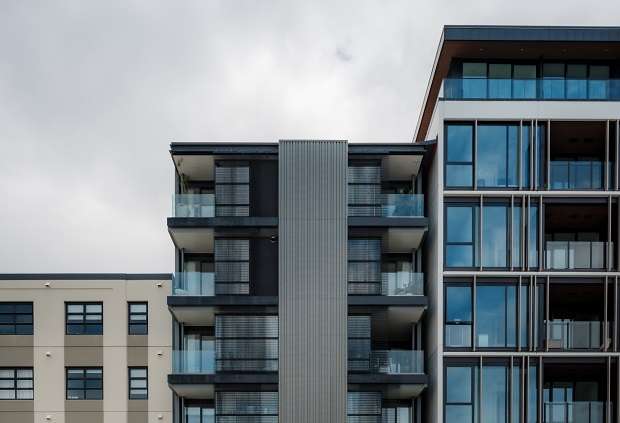In five years Auckland’s apartment scene has transformed.
Only five years ago if you wanted to live in an apartment in Auckland you had to choose a small one in a tower on a busy road in the city centre.
But now there are more apartments in the suburbs than the city centre. And if the suburb doesn’t have the amenities and transport, it shouldn’t have apartments, says Colliers International apartments expert Pete Evans.
“Now you’ve got plenty of choice and that choice is growing,” Evans says. “Having the train, buses, supermarket and cafes only a short stroll away is key.”
Start your property search
Buyers look at three main apartment types, he says - suburban, city fringe and city centre.
In the suburbs the apartment project will typically be smaller, low rise - a three to five storey walk up - and close to amenities and transport.
“Because if you give up a home, or even if it’s your first home, the reason you’d move into higher density is to be closer to amenity than if you weren’t in higher density.
“That’s the number one factor people should consider - location is the number one driver for apartment living.”
Amenities are more important than outlook for the suburban market, only because beautiful views push the price up another $15,000-plus per square metre.
“The affordable end of the market, which tends to be the suburban market, is more about the convenience.”
After location, buyers look at design and size, whether there is a good, functional layout, what the kitchen is like, the bedroom size, carparking - and storage is huge for day to day living and for resale.
Evans says new builds tending to be more spacious and comfortable. And while new apartments are not going down in size, that may happen as the city matures.
“If you include internal area and balcony, an average size on new products is around 85sq m, and that would typically be a two bedroom, two bathroom product.”
Most new apartments have full glass in the living room out to a balcony and they are up to Homestar 6-star rating so double glazing is standard.
Construction method is also important given the leaky building issues which caused havoc in many buildings built in the 1990s.
Anything built from 2005 on are mostly concrete or brick and you can be pretty confident in buying, Evans says.
“You’re protected by the whole building insurance side of it. Yes, developers did go broke all through the ‘90s and did wind up companies and all the rest of it but we have rarely seen that with new builds into the 2000s and certainly not from 2010.”
Apartments in the suburbs will set you back $400,000 to $1m mark, whereas in out in the city fringe they will typically be in the $1m to $3m mark.
The city fringe is defined as the good suburbs close to the city, and all the adjoining suburbs north, south, east and west such as Ponsonby.
“And actually people will pay more for a city fringe apartment than they will for a central city apartment.”
The “lifestyle changer” markets will opt for the city fringe, Evans says.

Pete Evans of Colliers says that more spacious apartments on the city fringe, close to amenities and public transport, are the growing sector. Photo / Ted Baghurst
They still go for the amenities but there are more of them and there might be more of a village feel.
People in the city fringe choose for the sun and the aspect. Not every apartment can face north but some people prefer the morning sun and some the afternoon sun, so that preference is worth factoring in to your selection, Evans says.
City fringe apartments tend to be five to eight stories with secure basement parking which adds to the cost of the build and therefore the price, while the city centre is high rises.
“You’re either close to the water and therefore more prestigious or you’re further up Queen Street but further away from the water but more affordable.
“There’s two types of buyers. There’s the businessman/mature type of market who will buy the bigger apartments, but that market is not that large, or overseas buyers or people who are more used to living in the CBD, but they’re not necessarily a lot of Aucklanders.”
The other market is the student/young professional/renter.
“If it’s an old unit it will be small. If it’s a new unit you’ll be paying higher rent. You fall very quickly into two categories, owner/occupier, the more luxurious, or, I’ll call it the older market, or you’re a rental product designed and built for six month, 12 month tenants, and every building almost chooses which one they are.”
Auckland city centre apartment specialist Martin Dunn from City Sales says if you want to make sure your apartment has good resale look at the body corporate minutes because some buildings are still facing bad remedial issues.
“It’s very important that buyers get a very lucid understanding of where any maintenance is up to with the building.”
Deal with a real estate agent who knows apartments, and find out the make up of the residents, he advises.
If it’s a new building check out the history of the developer - and be very careful of buying leasehold which makes up about 15 per cent of the central city market.
“Other than that the apartment market is a very, very legitimate market to buy into. We’re still getting a 4.5 to 5.5 per cent net return on apartments.”
City Sales sold a 50sq m apartment near the Town Hall this week for $425,000 which would rent at $600 a week.
“That’s about as high a return as you can get in residential; really good building, not glamorous, but that sort of drives the apartment markets.”













































































